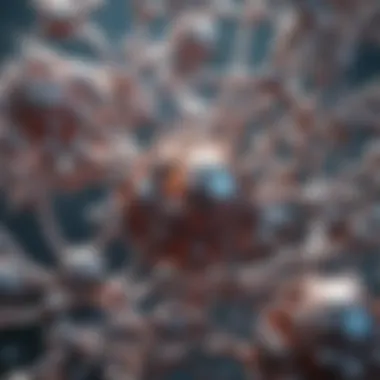Colloidal Zinc: Properties and Applications Explored


Intro
Colloidal zinc is gaining interest in both scientific research and various applications. Its unique properties and potential benefits are the subject of significant inquiry. This article aims to unpack the multifaceted nature of colloidal zinc, illuminating its chemical behaviors and practical uses.
Research into colloidal zinc has uncovered promising avenues for health benefits, particularly in areas such as dermatology and immune support. However, it is crucial to approach this topic with a critical lens, examining not only its advantages but also any safety considerations and limitations associated with usage.
Through detailed analysis of recent studies, this thorough examination will provide insights necessary for researchers, health professionals, and individuals seeking to understand the complexities of this compound.
Research Overview
Key Findings
- Colloidal zinc demonstrates antiviral properties, showing efficacy against certain pathogens.
- Its application in treating skin conditions, like acne and wound healing, has been supported by various clinical trials.
- Safety profiles indicate minimal side effects when used appropriately.
Study Methodology
Studies typically employ randomized control trials, observational research, and laboratory experiments. For instance, zinc's interaction with cellular processes is often explored through in vitro studies, providing foundational data for further research.
Background and Context
Historical Background
Zinc, an essential trace element, has long been recognized for its vital roles in various biological functions. Colloidal forms have been utilized for decades in both medicine and nutrition. Early usage highlighted its value in immune system support and skin health.
Current Trends in the Field
Research trends indicate a renewed focus on alternative therapies using colloidal zinc. Growing interest spans across various fields, including dermatology, immunology, and nutrition. Scholars are increasingly investigating its mechanisms of action to adapt colloidal zinc for innovative applications.
This examination will continue to explore both the established knowledge and emerging insights into colloidal zinc, guiding the discourse towards future research directions and potential breakthroughs in its application.
Intro to Colloidal Zinc
Colloidal zinc holds a significant position within both scientific research and various practical applications. This section serves as an essential introduction to this versatile compound, emphasizing its relevance in medicine, agriculture, and industrial uses. Understanding colloidal zinc's properties is fundamental for professionals in health and scientific fields, enabling them to explore its capacity as an effective therapy and a multifunctional agent in different sectors. The increasing interest in supplementing nutrition and promoting skin health further underscores the importance of discussing colloidal zinc in detail.
Definition and Composition
Colloidal zinc is a suspension of fine zinc particles in a liquid medium. It typically appears as a cloudy or opaque solution. These particles are so small that they do not settle at the bottom, which differentiates colloidal zinc from solutions where particles are completely dissolved. The size of the particles generally ranges from 1 nanometer to 1 micron. Their small size allows for a larger surface area, which increases the efficacy of their interactions at the cellular level.
The composition of colloidal zinc mainly includes elemental zinc in a colloidal form, often combined with a stabilizing agent to prevent aggregation. Water is the primary solvent in most formulations. Some products might include additional ingredients to enhance bioavailability or shelf-life. Understanding these components is vital for researchers and consumers looking to utilize colloidal zinc for its various health benefits.
Historical Background
The use of zinc as a therapeutic agent dates back centuries. Historically, zinc has been valued for its antibacterial properties and potential health benefits. In ancient Egypt, zinc was recognized for its healing effects, though the specific application of colloidal forms was not evident then.
The modern understanding of colloidal zinc began to develop in the early 19th century, as advancements in chemistry and medicine led to a greater exploration of metal nanoparticles. Over the years, researchers have studied its application in fields such as dermatology and immunology. By the late 20th century, colloidal zinc emerged as a popular dietary supplement, with a growing body of evidence supporting its role in wound healing and immune system support.
This historical context illuminates the evolving perceptions and applications of colloidal zinc, providing a foundation for the current interest in its properties and applications.
Chemical Properties of Colloidal Zinc
The chemical properties of colloidal zinc play a pivotal role in understanding its functionalities and applications. These properties define how colloidal zinc interacts with biological systems, environmental factors, and industrial materials. Gaining insights into these characteristics helps researchers develop effective strategies for utilizing colloidal zinc in various fields. Some key considerations include molecular structure, physical characteristics, and behavior in aqueous solutions.
Molecular Structure
Colloidal zinc consists of microscopic particles of zinc suspended in a liquid medium. The particles range in size, typically from one nanometer to several micrometers. Each particle has a particular arrangement of zinc atoms, which influences the overall behavior and reactivity of colloidal zinc. The specific molecular structure contributes to its unique properties, setting it apart from other forms of zinc.
Understanding the molecular structure is essential for grasping how colloidal zinc behaves in different environments. It impacts its effectiveness in applications like dietary supplements and agricultural products.


Physical Characteristics
The physical properties of colloidal zinc include appearance, solubility, and stability. Colloidal zinc often appears as a cloudy or opaque liquid, indicating the presence of dispersed particles. Its solubility is limited; however, it remains stable under certain conditions, which is crucial for its effectiveness.
- Particle Size: The average particle size affects each property such as surface area and reactivity.
- Viscosity: This impacts the flow properties, influencing its application in formulations.
These properties enable colloidal zinc to maintain its efficacy in various formulations, especially in supplements and topical applications. Evaluating these aspects is crucial to maximizing its potential benefits.
Behavior in Aqueous Solutions
When colloidal zinc is placed in an aqueous environment, its behavior can change significantly. It can become more reactive due to increased contact with other substances in the solution. The stability of colloidal zinc in water influences its use in biological and industrial applications.
Factors such as pH, temperature, and ionic strength can alter its stability:
- pH Levels: A change in pH can affect the charge on zinc particles, altering their interaction with cells or other compounds.
- Temperature: Higher temperatures could enhance kinetic energy, impacting the dispersion of particles in solution.
In summary, comprehending the behavior of colloidal zinc in solutions is vital for ensuring its effectiveness in therapeutic and industrial applications.
Understanding these chemical properties of colloidal zinc gives insight into its vast potential across various fields, providing a foundation for further research and exploration.
Mechanism of Action
Understanding the mechanism of action of colloidal zinc is crucial to appreciate its wide range of applications and benefits. This section will cover important aspects like its absorption and bioavailability, as well as its interactions at the cellular level.
Absorption and Bioavailability
Colloidal zinc is often praised for its improved absorption compared to other forms of zinc supplements. When taken orally, it is believed to be more bioavailable. This means that the body can utilize a higher percentage of the total zinc ingested.
The efficiency of absorption depends on several factors, including the presence of other elements in the digestive tract and the form of zinc consumed. Colloidal zinc maintains a stable suspension, which may enhance its solubility in the gastrointestinal tract. This allows for better uptake into the bloodstream, ultimately translating to more effective physiological benefits. Additionally, some studies suggest that colloidal forms do not significantly disturb intestinal flora, which can be a concern with other mineral supplements.
Cellular Interactions
The mechanisms by which colloidal zinc interacts with cells are complex and influential in physiological processes. This section will explore two significant aspects: its influence on cellular metabolism and its impact on gene expression.
Influence on Cellular Metabolism
Colloidal zinc plays a pivotal role in cellular metabolism. It functions as a cofactor for various enzymes involved in metabolic pathways, including those related to energy production. The presence of zinc enhances the activity of dehydrogenases and other essential enzymes, facilitating the conversion of nutrients into usable energy. Its role is not limited to energy metabolism; it also assists in protein synthesis and the overall maintenance of cellular structures.
Because zinc is involved in numerous metabolic pathways, it underscores its value in promoting overall cellular health. A unique feature of the zinc's influence on metabolism is its ability to stabilize cellular membranes. This stability is critical during cellular stress, such as that induced by oxidative stress, further emphasizing the importance of adequate zinc levels in the diet.
Impact on Gene Expression
Another significant aspect of colloidal zinc is its effect on gene expression. Zinc ions can influence various transcription factors, which are proteins that help regulate the transcription of DNA into messenger RNA. This means that zinc is integral in controlling the synthesis of proteins necessary for cellular function and response to environmental changes.
The capacity of zinc to modulate gene expression highlights its role in various physiological processes such as immune function, cell division, and repair mechanisms. A distinguishing characteristic of zinc’s impact on gene expression is its dual ability to act as a signaling molecule and a structural component of proteins involved in transcriptional regulation.
Like with cellular metabolism, the benefits of adequate zinc on gene expression cannot be overstated. However, excessive zinc can lead to imbalances that may affect gene regulation negatively, making it essential to monitor intake amounts.
The relationship between colloidal zinc and its mechanisms of action is critical for further exploration of its therapeutic potential and applications. Understanding these mechanisms enhances our perspective on how colloidal zinc might provide health benefits and improve general well-being.
Health Benefits of Colloidal Zinc
Colloidal zinc is gaining attention for its various health benefits. Understanding these benefits is vital for both researchers and health enthusiasts. This section will explore how colloidal zinc can enhance immune support, promote wound healing, and improve skin health, highlighting how each application contributes significantly to overall wellness.
Immune System Support
Colloidal zinc plays a crucial role in bolstering the immune system. Zinc is known for its properties in enhancing the activity of immune cells. It supports the proliferation of lymphocytes, which are critical in immune response. Studies suggest that adequate zinc levels can lead to a reduction in the duration and severity of illnesses, particularly respiratory infections.
Additionally, zinc has antioxidant properties. It can help combat oxidative stress, which can otherwise compromise the immune function. Thus, incorporating colloidal zinc into one's health regime may provide a proactive approach to maintaining immunity, especially during flu and cold seasons.


Wound Healing
The significance of colloidal zinc in wound healing cannot be overlooked. Zinc is essential for the synthesis of proteins and DNA, both of which are crucial for tissue repair. Research indicates that wounds heal faster when zinc levels are optimal.
When applied topically, colloidal zinc can accelerate wound closure and improve scar appearance. This effect is particularly important in clinical settings, where enhancing recovery times can have great impacts on patient care and outcomes.
Skin Health Applications
Colloidal zinc offers several applications in skin health, addressing various conditions effectively.
Acne Treatment
Acne is a prevalent skin condition, often requiring effective management strategies. Colloidal zinc contributes to acne treatment through its anti-inflammatory properties. It helps reduce the size and redness of acne lesions, making it a favorable option for many.
Another key characteristic of colloidal zinc in acne treatment is its ability to regulate sebum production, which is often a significant factor in the development of acne. This makes it a beneficial choice for those seeking to minimize breakouts without harsh chemicals, which can lead to further skin damage.
Psoriasis Management
Psoriasis is another chronic skin condition where colloidal zinc shows promise. This condition is characterized by rapid skin cell turnover, which leads to scales and inflammation. Colloidal zinc can help manage these symptoms by providing anti-inflammatory effects.
The unique feature of using colloidal zinc for psoriasis is its ability to soothe affected areas while promoting healing. However, it's essential to consider that while colloidal zinc can be helpful, results may vary among individuals. For some, comprehensive treatment plans may be necessary, involving other therapies as well.
"Colloidal zinc can help restore skin health, offering advantages in both acne management and psoriasis treatment."
In summary, the health benefits of colloidal zinc are noteworthy. From supporting the immune system to enhancing wound healing and improving skin conditions, its versatile applications make it a compound of interest across various health fields.
Applications of Colloidal Zinc
The applications of colloidal zinc cover a broad spectrum, showcasing its versatility and efficacy across various fields. Understanding these applications is important for contextualizing its role in nutrition, agriculture, and industry. Colloidal zinc not only serves as a dietary supplement, supporting health, but it also plays a crucial part in enhancing agricultural practices and bolstering industrial product efficacy. Each application area highlights specific benefits, characteristics, and considerations that are fundamental to its use.
In Nutritional Supplements
Colloidal zinc has become increasingly recognized in the health industry for use in nutritional supplements. This mineral contributes to various bodily functions, significantly supporting the immune system, which is critical for maintaining health. Its bioavailability as a colloidal form allows for better absorption compared to other zinc compounds. This increased absorption rate highlights its appeal for individuals seeking to boost their zinc intake effectively.
The unique feature of colloidal zinc in supplements lies in its liquid form, which is often easier to consume and integrate into daily health regimens. This adaptability has led to its popularity among consumers, especially those who prefer liquid over pills. However, potential side effects should also be monitored, emphasizing the importance of adhering to proper dosage guidelines.
In Agriculture
The significance of colloidal zinc in agricultural practices stems from its essential role in plant health and development. Zinc is a crucial micronutrient, and its availability can significantly impact crop yields and quality.
Fertilizers
Colloidal zinc is incorporated into fertilizers to enhance plant nutrient profiles. The use of zinc in fertilizers is essential since zinc is often deficient in many soils, particularly those with high pH levels. The key characteristic of colloidal zinc fertilizers is their ability to provide a readily available source of the nutrient. It drives improved growth rates and overall plant vitality. This is beneficial for maximizing agricultural output and ensuring food security.
One unique aspect of using colloidal zinc in fertilizers is that it can be absorbed quickly by plant roots. This feature means crops can receive nutrients exactly when they need them, leading to a more efficient fertilization strategy. However, care must be taken not to over-fertilize, which can lead to adverse environmental impacts.
Fungal Resistance
In addition to its role in fertilizers, colloidal zinc shows promise in enhancing plant resistance to fungi. This is particularly important in maintaining crop health and reducing reliance on chemical fungicides. The critical characteristic of colloidal zinc in promoting fungal resistance is its influence on plant metabolic pathways. It helps to fortify plants against diseases, which can have significant economic benefits for farmers.
The unique benefit here is the dual effect of providing essential nutrients while simultaneously acting as a natural deterrent against fungal growth. However, the exact mechanisms and effectiveness can vary. This calls for ongoing research to refine its application in agricultural systems.
In Industrial Applications
Colloidal zinc also finds a place in various industrial applications, showcasing its utility beyond health and agriculture. Its properties make it suitable for several sectors, including cosmetics and coatings.
Cosmetic Products
In cosmetic formulations, colloidal zinc is often valued for its skin-soothing properties. It has a well-documented role in treating skin irritations and promoting healing. The unique aspect of colloidal zinc in cosmetics is its non-greasy finish, making it appealing for formulations aimed at oil-prone skin types. Its absorbent properties make it a beneficial ingredient in products like sunscreens and creams.


However, users should be aware of concentration levels, as high amounts may cause irritation for some individuals. Thus, careful formulation is necessary to retain its beneficial effects while ensuring safety.
Anti-corrosive Coatings
Another prominent application of colloidal zinc is in anti-corrosive coatings. It is used in various industries, particularly in construction and manufacturing, where metal protection is necessary. The key characteristic of these coatings is their ability to prevent rust and corrosion effectively, prolonging the life of metal structures.
Colloidal zinc-based coatings provide a unique defensive layer that reacts with environmental elements to inhibit corrosion processes. This effectiveness makes them a preferred choice in environments subjected to harsh conditions. However, it is essential to consider application methods and surface preparation to achieve optimal results.
Safety and Toxicity Considerations
Understanding the safety and toxicity of colloidal zinc is vital for both consumers and practitioners. While colloidal zinc is recognized for its health benefits, it is essential to evaluate the potential risks associated with its usage. Safety considerations inform dosage guidelines and prevent adverse effects, ensuring that individuals can make informed decisions regarding their health.
Potential Side Effects
Colloidal zinc, like any supplement, can cause various side effects. Most individuals tolerate it well, but some may experience gastrointestinal disturbances. These can include nausea, vomiting, or diarrhea. Additionally, some users report dizziness or changes in taste. It is crucial to monitor for these side effects, especially during the initial use. Furthermore, excessive intake of zinc can lead to more significant health concerns, such as immune system suppression and copper deficiency. Hence, understanding these potential side effects is essential for safe consumption.
Dosage Guidelines
Establishing appropriate dosage guidelines is crucial when using colloidal zinc. The right amount can help achieve desired health benefits while minimizing risks. Generally, for adults, the recommended dosage is between 15 to 30 milligrams of zinc per day, depending on individual health conditions and needs.
It is beneficial to consider these tips while using colloidal zinc:
- Start with a lower dose to assess tolerance.
- Gradually increase the amount if no side effects occur.
- Stick to recommended daily allowances as high doses over an extended period can be harmful.
- Consult with a healthcare provider, particularly for those with existing health conditions or who are pregnant or breastfeeding.
Proper understanding of safety and dosage ensures that colloidal zinc can be used effectively without unnecessary risk.
Current Research on Colloidal Zinc
Current research on colloidal zinc signifies an evolving understanding of its multifaceted properties and potential benefits. This section highlights recent findings, underscoring how studies continue to refine knowledge about colloidal zinc's effectiveness in various applications. These investigations are crucial as they not only validate the existing claims regarding this compound but also open avenues for novel applications and therapeutic understanding.
Experimental Studies
Experimental studies form the foundation of the scientific inquiry surrounding colloidal zinc. Researchers explore its effectiveness in both biological and environmental contexts. For instance, studies have examined how colloidal zinc interacts with cellular processes. The research indicates that zinc's precise form, such as its colloidal state, can significantly enhance its bioavailability.
In addition, animal models have shown enhanced wound healing when treated with colloidal zinc. These studies frequently assess the rate of healing and tissue regeneration. Other experimental approaches involve investigating the impact of colloidal zinc on gene expression patterns and cellular metabolism. This information is crucial for understanding its roles in health and disease management.
Clinical Trials
Clinical trials offer insights into the practical implications of colloidal zinc usage. A number of trials have been conducted to evaluate its efficacy in supporting immune function and treating skin conditions such as acne and psoriasis. Results often reveal that patients supplementing with colloidal zinc experience fewer symptoms and faster recovery rates.
For example, one significant trial investigated the impact of colloidal zinc on patients with chronic skin issues. Observations noted the reduction of inflammatory markers and improvement in skin appearance. The dosage and application method varied, shedding light on the best practices for potential therapeutic uses.
"Clinical trials are pivotal in bridging the gap between laboratory findings and real-world applications, revealing the practical benefits of colloidal zinc."
Such findings underscore the importance of ongoing research in this area. As clinical studies progress, they may lead to refined recommendations for dosage and application across different demographics.
Future Directions in Colloidal Zinc Research
Future directions in colloidal zinc research hold significant importance in expanding our understanding of this compound and its diverse applications. The growing body of research offers countless opportunities to explore new innovative applications that can harness colloidal zinc's unique properties. This section highlights potential avenues for research, illustrating how further exploration can lead to better health outcomes and advancements in various fields.
Innovative Applications
The innovative applications of colloidal zinc span a multitude of domains, from medicine to agriculture. Recent findings suggest several promising areas:
- Nanotechnology: Colloidal zinc may serve as a foundation for developing nanocarriers to improve drug delivery systems. This could enhance the bioavailability of certain medications, making treatment options more effective.
- Food Fortification: There is potential in using colloidal zinc to fortify foods, especially in regions where zinc deficiency is common. Given its bioavailability, it may provide a practical solution for improving nutritional status in vulnerable populations.
- Cosmetic Formulations: In the realm of skincare, colloidal zinc's anti-inflammatory properties position it as a valuable ingredient in products meant for acne treatment or skin barrier repair. Further research could solidify its role in enhancing product efficacy.
"As research progresses, the applications of colloidal zinc seem boundless, offering not only health benefits but also economic advantages in fields like agriculture and cosmetics."
Interdisciplinary Research Opportunities
Colloidal zinc research presents unique interdisciplinary opportunities that can enhance our understanding of this compound. Collaborations across various fields could yield important insights:
- Biomedical Engineering: Researchers in this field may focus on how colloidal zinc can be incorporated into tissue engineering and regenerative medicine. Investigating its role in promoting cell growth and improving healing could lead to breakthrough therapies.
- Environmental Science: Understanding the interactions between colloidal zinc and ecosystems can have implications for agricultural practices. Studies can explore its effects on soil health and plant growth, leading to sustainable farming methods.
- Pharmacology: Exploring the pharmacodynamics and pharmacokinetics of colloidal zinc could uncover new therapeutic uses. This includes studying how it interacts with other pharmaceuticals, which may reveal synergistic benefits.
As research in these directions progresses, the true potential of colloidal zinc will likely become more evident. Its multifaceted nature calls for a concerted effort to tap into its possibilities, benefiting not just one field, but many.







